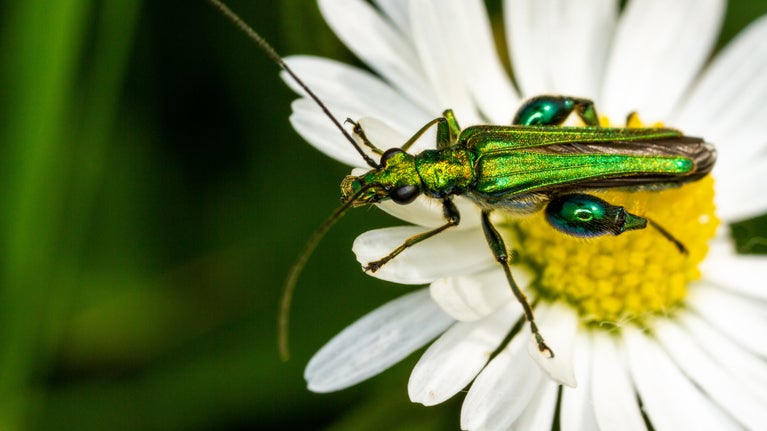
Get closer to wildlife
Discover tips for spotting mammals, birds and insects each season and learn about the range of wildlife at the places we look after.

The places we look after are home to every species of bat that lives in the UK. Find out when and where to spot them and use our guide to learn more about different types of bat, from rare species such as the barbastelle to the tiny common pipistrelle bat.
The best time to spot bats is from May to September. They typically begin hibernating from October through to March or April, so the summer months are the best time to see them flying. The first half hour after sunset is when you’re most likely to see them.
Climate change means that some bats are extending their range to the north of the country, where it's becoming warmer to live. During winter hibernation, if the temperature reaches above 7 degrees and insects are flying, bats wake up to feed before going back to sleep.
Bats need easy access to feeding sites as well as roosting sites. They like areas free from light pollution, woodland avenues and long bushy hedgerows, so they can move between areas without being exposed out in the open.
Bats aren't blind, they can actually see very well. However, at night their ears are more important than their eyes. Bats shout as they fly, and the returning echoes give them information about what’s ahead of them. This is called echo location.
Bat shouts are so high in frequency that they're inaudible to us. We use a bat detector to tune in to them, which translates the ultrasound into a frequency we can hear. During the mating season you’ll hear male bats serenading females.

The common pipistrelle bat can eat around 3,000 tiny bugs each night including midges, moths and lacewings. This is the equivalent of one third of its body weight. For an adult human this is the same as eating around 137 sandwiches or 24kg of food every day.
During cold or wet summers, when there aren’t many bugs to feed on, bats can go into a semi-hibernating state known as ‘torpor’. This means they use less energy and can conserve their resources until the weather warms up.
This bat is similar to the whiskered and Brandt’s bats. The species has been recorded in Yorkshire and the south of England since 2009. Wingspan: 20cm. Body length: 40mm.
This is a rare bat, found in ancient woodland in the south of the UK. The barbastelle has a distinctive 'pug-like' appearance due to its upturned nose, and its ears are joined at the base. Wingspan: 27cm. Body length: 45mm.
This is a rare bat, restricted to ancient woodlands in the south of England. It has the longest ears of any European bat after the long-eared bat, measuring about 25mm. Wingspan: 28cm. Body length: 45mm.
This is a woodland bat that has ears about 28mm long. These navigate them to food including the tiniest of insects. Wingspan: 25cm. Body length: 45mm.
Also known as the ‘water bat’, it often roosts in trees. Its large feet distinguish it from other bats. Wingspan: 25cm. Body length: 45mm.

This is Britain's biggest bat. There’s only one site where it’s known to reside, near the south coast. Wingspan: 40cm. Body length: 70mm.
This bat is restricted to England, south of the Thames. It differs from the more common brown long-eared bat as it has darker fur. Wingspan: 25cm. Body length: 45mm.
Restricted to the south west of England and Wales, both lesser and greater horseshoes have declined in number. In summer they roost in roof spaces. In winter, they use underground sites such as caves. Wingspan: 34cm. Body length: 64mm (greater horseshoe). Wingspan: 25cm. Body length: 40mm (lesser horseshoe).
Common in Ireland, this high-flying bat roosts in buildings and trees. Wingspan: 30cm. Body length: 64mm.
This is a parkland and woodland species that often roosts in tree hollows, barns and roofs. It's distinguished by its white belly. Wingspan: 28cm. Body length: 45mm.
This tree-roosting species forages widely and is one of Britain's largest bats. It often emerges before dark in the summer to catch insects. Wingspan: 36cm. Body length: 75mm.
There are three species of Britain's smallest bat, common, soprano and Nathusius’ pipistrelle. They often roost in modern houses but are found roosting and foraging everywhere. Our most common bat species, pipistrelles live in colonies of 1,000 or more. Wingspan: 22cm. Body length: 35mm.
Restricted to the southern half of England and south Wales, this bat roosts in houses, foraging over pasture and gardens. It returns to the same roost year after year. Wingspan: 36cm. Body length: 64mm.
Often found in woodland and on the waterside, these two species are remarkably alike. Whiskered bats have more fur around their eyes and muzzle than other bats. Wingspan: 24cm. Body length: 40mm.

Discover tips for spotting mammals, birds and insects each season and learn about the range of wildlife at the places we look after.
Learn how to spot red squirrels, the best times to see them and how to tell them apart from grey squirrels.

Barn owls are instantly recognisable from their heart-shaped faces and distinctive feathers. Learn where they prefer to hunt and nest, and the kinds of habitats they use at the places in our care.

Take a look at our guidelines for responsible seal spotting and top tips for seal watching.

Discover what wildlife and wildflowers you can see in meadows this summer, including butterflies, grasshoppers, moths and orchids.
